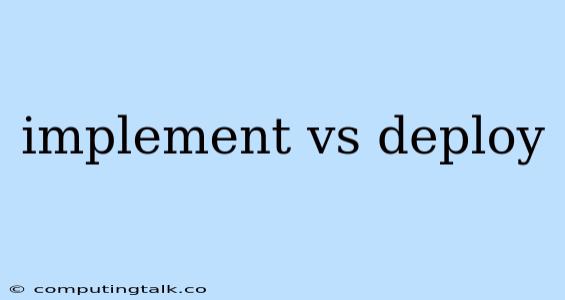The terms "implement" and "deploy" are often used interchangeably in software development, but they have distinct meanings and represent different stages in the software lifecycle. Understanding the difference between implementation and deployment is crucial for efficient project management and successful software delivery.
What is Implementation?
Implementation refers to the process of building and testing a software application or system. This phase involves writing code, integrating components, and ensuring that the software meets the specified requirements. In essence, implementation is about bringing the design of the software to life.
Key Activities in Implementation:
- Coding: Writing the actual code that comprises the software application.
- Testing: Thoroughly testing the code to identify and fix bugs, ensuring that the software functions as intended.
- Integration: Combining different components of the software into a unified whole.
- Configuration: Setting up the software environment and parameters.
- Documentation: Creating documentation for the software, including user manuals and technical specifications.
What is Deployment?
Deployment, on the other hand, is the process of making the implemented software available to users. It involves transferring the software from a development environment to a production environment, where it can be accessed by end users. Deployment ensures that the software is ready for use in a real-world setting.
Key Activities in Deployment:
- Staging: Preparing the production environment to receive the software.
- Installation: Installing the software on the production servers.
- Configuration: Configuring the software for the production environment.
- Testing: Conducting final testing in the production environment to ensure seamless operation.
- Release: Making the software available to users.
Implementation vs. Deployment: A Detailed Comparison
| Feature | Implementation | Deployment |
|---|---|---|
| Focus | Building and testing the software | Making the software available to users |
| Environment | Development environment | Production environment |
| Activities | Coding, testing, integration, configuration, documentation | Staging, installation, configuration, testing, release |
| Goal | Create a functional software system | Make the software accessible and operational |
The Importance of Distinguishing Implementation and Deployment
Clearly distinguishing between implementation and deployment is vital for several reasons:
- Effective Project Management: By separating these two phases, project managers can better allocate resources and track progress.
- Improved Communication: Using precise terminology ensures clear communication between developers, testers, and operations teams.
- Enhanced Quality Control: Separate testing phases for implementation and deployment ensure that the software is thoroughly tested at each stage.
- Faster Time to Market: By streamlining the deployment process, organizations can get their software into the hands of users more quickly.
Example Scenario
Imagine you're building a new online store.
- Implementation: This phase involves coding the website's features, such as product display, shopping cart, and checkout. Developers write code, test it rigorously, and ensure everything functions as expected.
- Deployment: Once the online store is fully implemented, it's deployed to a production server, making it accessible to customers. This includes setting up the server, installing the software, and configuring it for the live environment.
Conclusion
Implementation and deployment are distinct but interconnected phases in the software lifecycle. Implementation focuses on building and testing the software, while deployment focuses on making it available to users. Understanding the differences between these two phases is crucial for effective project management, clear communication, and successful software delivery.
